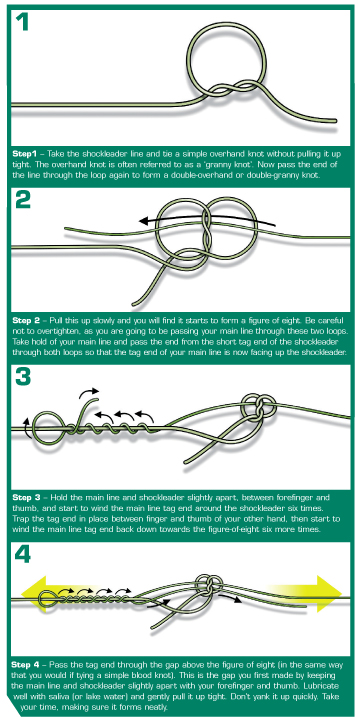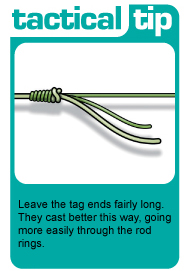David Mills wrote:
I have just started fishing. Could you tell me the best knot to use to join a main line to a hook line? At present I’m using a 6lb main and 4lb hook line.
Hi David, I wrote an article on the type of knot you wish to know about a few months back. So I’ll re-post it below for you. I hope it helps, while I generally use heavier line for carp, the knots I mention below will work with all breaking strains.
Regards
Gareth
Shock Leaders, Lines & Knots: What you Need to Know!
by Gareth Watkins

Long range casting is something we all want to achieve. Modern carp gear is better and more efficient in this area than ever before, and relatively modest rods and reels are capable of huge distances. So for most anglers you don’t necessarily need the hugely expensive tackle to improve your distance. A fine tuning of your set up and a good technique will see the average casters putting in pretty good performances.
One of the main ways you can add distance to a cast is by dropping your line diameter down to the 30/100 or 28/100. Now line diameter is a far better indicator than breaking strain. Forget the stated strength; diameter is what you should be looking for on the label. Good lines for this include Shimano Catana, and P-Line.. These lines will typically be stated at 8-10lb but will normally break far above these weights.
When you reduce line strength to these diameters it is imperative you use a shock leader to avoid cracking off. There are several types of material you can use for leaders.
Heavy Nylon: For a long while anglers used thicker nylon as a leader material, which while it worked was far from the ideal choice. For a start its thickness made it very difficult to tie a good knot with the thinner main line. This knot was also very difficult to make strong enough to have any real confidence in. It is very hard to tie a strong, reliable knot with two lines of such great variation in thickness.
Tapered Leaders: More recently we have seen the use of tapered shock leaders that have been available from a number of tackle manufacturers such as Fox. They are often of around 15lb at the one end going up to 45lb at the rig end. While the offer the possibility of a strong knot between main line and leader, the nylon does have a fair amount of stretch and remains far less abrasion resistant than other alternative leaders. I found that these cut off very easily when fishing the river Seine. These are useful if braid is not allowed on your particular venue.
New Shimano tapered leader: Recently Shimano has been developing a new spool of line in their surf casting range that is perfect for distance carp fishing. A tapered surf line eliminates the need for knots that are potential weak spots and can significantly hamper casting distance. Made in Japan, the Speedmaster Tapered Surf Line comes in 4 variations, all on 220 metre spools. Its diametre varies from 23/100 to 37/100 at the thin end finishing at 57/100 at the rig end. On waters that don’t allow braid or tied on shock leaders you have a product that will allow you to fish at range.
distance carp fishing. A tapered surf line eliminates the need for knots that are potential weak spots and can significantly hamper casting distance. Made in Japan, the Speedmaster Tapered Surf Line comes in 4 variations, all on 220 metre spools. Its diametre varies from 23/100 to 37/100 at the thin end finishing at 57/100 at the rig end. On waters that don’t allow braid or tied on shock leaders you have a product that will allow you to fish at range.
Braid: Many anglers though will prefer braid as a leader material and where it is allowed this would be my choice. Braid has the major advantage of zero stretch, so all your effort in the cast is transferred into compressing the blank. Braid is also finer for a given breaking strain and thus far easier to tie to your main line. Knots, the natural weak link, will therefore be less likely to break. There are a number of makes of braid on the market, one of the good ones for leaders is by Korda called Arma-Cord, it comes in 20m spools of 30lb and 50lb.
Knots: This then brings me on to the type of knot needed to attach your leader. This for me has been narrowed down to one knot shown to me by Shaun Harrison and is his adaptation of an old fishing knot, and is similar to the knot made famous by the Mahin brothers in France. Check out the diagram above, and the tip from Shaun Harrison also.
I hope this helps you with your casting set up.
Regards
Gareth

Comments